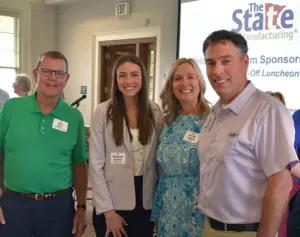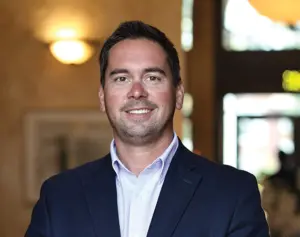John Connelly, Enterprise Minnesota’s vice president of consulting, recently celebrated his 30th year with the company. An essential part of his responsibilities has been to manage Enterprise Minnesota’s connection to the Manufacturing Extension Partnership (MEP) national system and its nationwide network of industry resources.
MEP’s national system provides U.S. manufacturers access to resources to develop new products and customers, expand and diversify markets, adopt new technology, and enhance value within supply chains. Through his connection with MEP’s national system of 51 independent centers and 1,450 field staff, Connelly is well-positioned to understand manufacturers’ challenges and opportunities.
After graduating with a degree in business administration from Penn State, Connelly started his career as a regional sales manager and sales/marketing manager for a manufacturer of automotive wheel service equipment. He has served as a regional sales manager and customer service manager for a manufacturer of engineered motion controls, as a director of program management for a gear systems manufacturer serving the aerospace industry, and as a general manager for a tooling and machining company.
Connelly is a frequent speaker at industry events and a published writer on manufacturing trends and best practices.
Is it fair to say that many people — even your customers — don’t have a strong sense of what MEP does and how it works alongside Enterprise Minnesota?
John: Many people still describe it as a best-kept secret. The MEP Initiative is housed in NIST — the National Institute of Standards and Technology — which is part of the Department of Commerce.
Back in the late ’80s, when we (as Minnesota Technology, the original name of Enterprise Minnesota) pursued our application to become part of the MEP, the state of Minnesota’s vision for supporting manufacturing overlapped very tightly with MEP’s language to improve the competitiveness exclusively of small- and medium-sized manufacturers of manufacturing. We were in the second cluster of MEP’s first seven regional centers, the Upper Mississippi Manufacturing Technology Center.
The challenge was that they were trying to cover multiple states, but the funding formula supporting them required the states to be part of the funding. They ran into states that were happy to support manufacturers in their state, not other states. That led to the evolution that every state would have an MEP center.
What was the origin of the MEP?
John: The MEP model grew from the ag extension services decades ago. The ag extension was put together when most farms were family farms that were insulated from each other because everything revolved around the work they did on their farm. The ag extension agents brought them science, technology, and college advice to strengthen them. So, that’s a little bit of what we do. We reach out to individual manufacturers to try and bring them experience and advice.
What has given you the greatest surprise as you’ve worked with Minnesota’s manufacturers for 30 years?
John: I don’t think I would call it a surprise as much an enlightenment. In the early stages, there was the belief that everything was about advanced manufacturing. Our focus was almost exclusively on productivity, as manufacturers looked at significant emerging competition from Japan.
Each MEP center was dedicated to helping manufacturers understand and utilize the basic elements of lean and continuous improvement. We were all talking about machining centers, tooling, and speed rates. Over the years we started to recognize how leadership teams are either the single biggest lever to help a business forward, or the single biggest obstacle to growth.
What I find enlightening is all that emphasis on hardware and software process really subordinates itself to leadership, vision, commitment, and skill to communicate. We progressed from lean to quality management systems, and from there, we moved to strategy and marketing and then to leadership.
What gives you the greatest source of satisfaction working with manufacturers?
John: It’s every time I get a chance to walk into a manufacturing facility or talk to a consultant about what they’re going to do to help a manufacturer. I was in Two Harbors recently and had a chance to talk to one of our new customers. We talked about the things the business is going through and looked at their product line. While the new product is huge, it doesn’t generate the kind of margins we’re after. So, we talked about how we might efficiently improve that. I still love those conversations.
Yesterday I was in Staples and Detroit Lakes with a couple of our new consultants, really expert, skilled people. We were talking about how they can propose ideas to clients who might say, “we know better” and “we’re unique.”
I really enjoy those conversations with individual consultants. What should I say? How could I say it? How could I do it? I love helping consultants find ways to help their clients understand what they’re facing, and what they’re thinking about.
Return to the Fall 2023 issue of Enterprise Minnesota® magazine.


